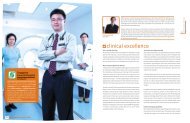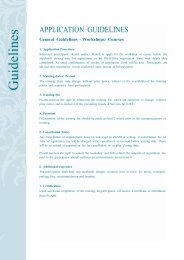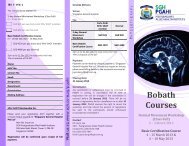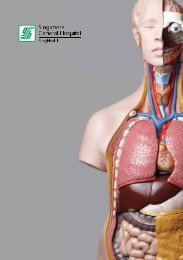You also want an ePaper? Increase the reach of your titles
YUMPU automatically turns print PDFs into web optimized ePapers that Google loves.
SGH BURNS CENTRE<br />
Treating scars<br />
inside and out<br />
The unit has cared for<br />
burn victims in several<br />
high profile disasters<br />
and terrorist attacks<br />
lamie Ee Wen We<br />
ST FILE PHOTO NG SOFt LUAN<br />
Lance Corporal Chow Han Min one of two critically injured local soldiers in the Taiwan<br />
fighter jet crash in 2007 being rushed to the SGH Burns Centre for treatment
Yio Chu Kang MP Seng Han Thong<br />
who was set on fire by a man last Sun<br />
day is making progress at the <strong>Singapore</strong><br />
<strong>General</strong> <strong>Hospital</strong> s SGH Burns Centre<br />
Intensive Care Unit ICU<br />
He suffered 14 per cent burns to his<br />
body but is now in stable condition He<br />
was taken off the respirator last Friday<br />
and is breathing on his own<br />
It could well be the first time an MP<br />
has been warded at the centre which Is<br />
on the third level of Block 4 in SGH But<br />
the doctors and nurses who work there<br />
are more than ready to put Mr Seng<br />
back on the road to recovery<br />
Their track record includes dealing<br />
with victims from several high profile<br />
incidents over the last decade the Sin<br />
gapore Airlines plane crash in Taipei in<br />
2000 the Ball bombings in 2002 two<br />
terrorist attacks in Indonesia in 2003<br />
and 2005 and the Taiwan military jet<br />
crash in 2007<br />
Even the birth of the centre was dur<br />
ing trying times after the explosion of<br />
Greek tanker Spyros injurong Shipyard<br />
which killed 76 people and injured near<br />
ly 69 It is still considered the worst in<br />
dustrial accident in <strong>Singapore</strong><br />
It was chaotic then There was no<br />
specialised burns facility so the Ministry<br />
of Health and SGH saw a need to start<br />
one said Associate Professor Colin<br />
Song SGH s head of department of plas<br />
tic reconstructive and aesthetic surgery<br />
and director of the SGH Burns Centre<br />
Prof Song who has been with SGH<br />
since 1997 and became the head of the<br />
department in 2004 is no stranger to<br />
the limelight<br />
In the past week he has been tasked<br />
to give updates on Mr Seng s condition<br />
Asked if there is stress in treating an<br />
MP he said I would liken it to treating<br />
our national servicemen Everybody is<br />
expecting him to do well You get a lit<br />
tle bit of stress because you know that<br />
everything s got to work well<br />
But it s becoming quite easy be<br />
cause it s almost automatic<br />
As the only major specialised facility<br />
managing major burn injuries in the re<br />
gion the centre with eight doctors 34<br />
nurses and a host of therapists and sup<br />
port staff has been at the forefront of<br />
treatment in major disasters that have<br />
hit the region in the past decade<br />
In October 2000 flight SQ 006<br />
crashed in Taipei killing 83 and leaving<br />
behind 57 injured of whom three were<br />
sent to the centre here<br />
We really felt this was a national dis<br />
aster because the air force was out there<br />
in the interests of our safety We also<br />
had to send our own team to bring our<br />
<strong>Singapore</strong>ans back said Prof Song<br />
Once the trio arrived in <strong>Singapore</strong><br />
they had extensive surgery that lasted<br />
12 hours While they remained in criti<br />
cal condition for days they were eventu<br />
ally nursed back to health<br />
Then came the biggest challenge to<br />
the centre in 2002<br />
During the bombing at Kuta Beach<br />
in Bali considered the deadliest act of<br />
terrorism in Indonesia 15 people with<br />
severe bums were evacuated to the cen<br />
tre with eight admitted to the ICU<br />
Principal scientific officer Alvin<br />
Chua who heads the skin bank unit in<br />
the centre recalls a shortage of cadaver<br />
skin then<br />
Prior to this attack no emergency<br />
had ever called for that massive an<br />
amount of cadaver skin<br />
On Oct 14 2002 when the patients<br />
arrived from Bali there was 9 100 sq cm<br />
of cadaver skin in the skin bank By Oct<br />
18 only about half was left<br />
Fortunately a prior request for substi<br />
tute skin was made to the University of<br />
Texas Southwestern Medical Centre in<br />
the United States which responded by<br />
sending over 20 000 sq cm<br />
Another problem was a shortage of<br />
blood products following the many op<br />
erations performed for victims of the at<br />
tack<br />
That problem was resolved when the<br />
National Blood Bank was able to obtain<br />
more blood at short notice through<br />
blood donation drives and recalling reg<br />
ular donors<br />
With the sudden influx of patients<br />
off duty staff were recalled with addi<br />
tional nurses from other departments<br />
roped in to help The team worked<br />
12 hour shifts in the days following the<br />
attack<br />
Prof Song said It was a time when<br />
we were frantically busy but we were<br />
never at a stage where we were exhaust<br />
ed because managing these major burn<br />
injuries is about putting the organisa<br />
tional aspect of mass casualty treatment<br />
in place<br />
That s the time when the team has<br />
to come through Everybody knows his<br />
role everybody knows his contribution<br />
to the patient s welfare and once you<br />
are working as a team there s no time<br />
to feel fatigued<br />
As many of the patients were foreign<br />
ers American British Swiss French<br />
Irish Canadian and Japanese nurse cli<br />
nician Lee Lay Eng 51 recalled that in<br />
terpreters were brought in<br />
One patient a doctor died af<br />
ter a 24 day ICU stay but the<br />
others survived<br />
Prof Song said<br />
Losing the ones<br />
that we lose we sit<br />
back and have a<br />
deep breath and take<br />
away lessons and try<br />
to better ourselves so<br />
that the next time<br />
around nobody has to<br />
die<br />
He added that there<br />
was a review of the cen<br />
tre s disaster plan after<br />
the 2000 and 2002 ernei
ceiE sci<br />
gencies<br />
In particular the facility was renovat<br />
ed and the number of ICU cubicles was<br />
doubled to nurse eight patients in a cri<br />
sis<br />
When the 2003 Jakarta and 2005 Ball<br />
attacks came the centre was better pre<br />
pared and did not face any further short<br />
age of skin All the 16 patients survived<br />
Throughout the three terrorist at<br />
tacks the centre continued to function<br />
normally admitting patients from Sin<br />
gapore and abroad The 29 bed unit<br />
treats about 93 per cent of all bums cas<br />
es here The rest are admitted to the oth<br />
er hospitals here<br />
Up to a quarter of the 200 patients or<br />
so admitted every year are those consid<br />
ered to have sustained major bums<br />
In the past the burns unit was a de<br />
pressing place to be in said Prof Song<br />
Nurse Lee said The general appear<br />
ance of the wounds can be pretty trau<br />
matic especially if the surface area is<br />
big<br />
It is also not uncommon for patients<br />
to scream in pain<br />
But modern techniques have<br />
changed things Prof Song said patients<br />
now go through skin grafting early in or<br />
der to minimise the setting in of early<br />
life threatening infection and they do<br />
not require as much dressing<br />
Most patients typically go through a<br />
long period of recovery<br />
When it s taking such a long time<br />
they get frustrated They always ask<br />
why so little progress said nurse Lee<br />
Then there is also the disfigurement<br />
and sometimes disability that patients<br />
have to deal with Which is why there<br />
are counsellors and therapists in the cen<br />
tre to work with the patients until they<br />
have fully recovered<br />
Of the success stories from the cen<br />
tre the one of 25 year old Karthigayan<br />
Ramakrishnan seems to be on every<br />
one s lips<br />
He was injured in Taiwan when a<br />
fighter jet crashed into a storeroom on<br />
May 11 2007 The accident killed three<br />
<strong>Singapore</strong> soldiers and two Taiwanese<br />
pilots<br />
He was among the two soldiers airllft<br />
ed back One died more than two weeks<br />
later but Third Sergeant Ramakrishnan<br />
who was warded for more than six<br />
weeks pulled through<br />
One of the key things the centre is<br />
looking at is to increase its skin dona<br />
tion<br />
From 1998 to 2007 there were only<br />
50 donors Last year there were two<br />
far short of what s needed to treat pa<br />
tients here<br />
Prof Song said More awareness<br />
needs to be created to let people know<br />
of the need for skin<br />
jai iSt tiesph<br />
TYPES OF BURNS<br />
Superficial burns<br />
Involve only the outer layer of the skin that<br />
is the epidermis and are characterised by<br />
redness swelling and tenderness<br />
Examples are mild sunburn or a scald produced<br />
by a splash of hot water<br />
They usually heal well if first aid is given<br />
promptly and do not require medical attention<br />
Partial thickness burns<br />
Penetrate more deeply destroying all the<br />
epidermal layers and extending into the dermis<br />
The skin will look raw and blisters will form<br />
Partial thickness bums affecting more than 30<br />
per cent of the body s surface can be fatal<br />
Full thickness burns<br />
All layers of the skin are burned<br />
There may also be damage to tissue nerves<br />
muscles and blood vessels<br />
Such burns need immediate medical attention<br />
and will usually require specialist treatment<br />
WHAT TO DO WITH<br />
A thermal bum<br />
This involves heat or fire such as when your<br />
clothes catch fire or when you are scalded by hot<br />
water<br />
The first act of thermal burn treatment is to<br />
stop the burning process<br />
In the case of a fire use a wet cloth or blanket<br />
to smother any flames<br />
Run the burned area under cool running water<br />
for 15 minutes or more or apply a cold gel pack<br />
Cover the burned area with a sterile gauze pad<br />
or a clean cloth<br />
An electrical burn<br />
This happens when a current from an electrical<br />
outlet cord or appliance passes through the<br />
body<br />
Switch off the source of electricity to prevent<br />
further electrocution<br />
Check the victim s pulse and breathing If<br />
none is detected perform CPR and rescue<br />
breathing<br />
Cover the burned area with a sterile gauze pad<br />
or a clean non fluffy cloth<br />
A chemical burn<br />
This happens when the skin comes into<br />
contact with strong chemicals like bleach and<br />
thinner<br />
Flush the chemicals off using cool running<br />
water for 15 minutes or more<br />
Remove clothing or jewellery that has been<br />
contaminated by the chemical<br />
Cover the burned area with a dry sterile<br />
dressing or a clean cloth<br />
For all the cases seek medical help If the<br />
burns are deep or extensive<br />
WHAT NOT TO DO<br />
Do not apply ice directly to the burn<br />
Do not break blisters<br />
Do not apply lotions ointments or fat like<br />
butter to the injured area<br />
In<strong>format</strong>ion from the <strong>Singapore</strong> <strong>General</strong><br />
<strong>Hospital</strong>


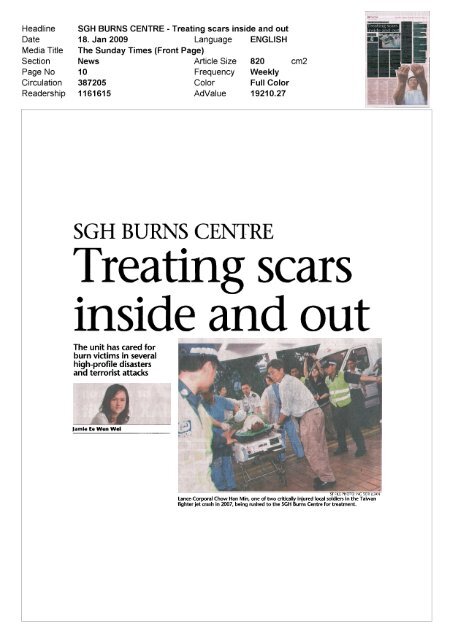
![help document [pdf]](https://img.yumpu.com/26291587/1/190x245/help-document-pdf.jpg?quality=85)
